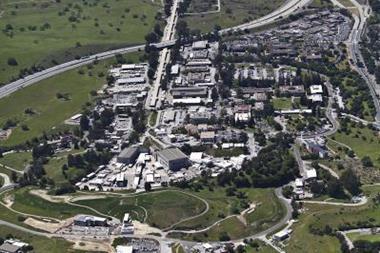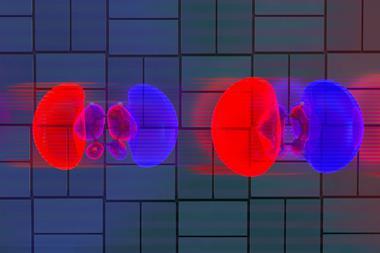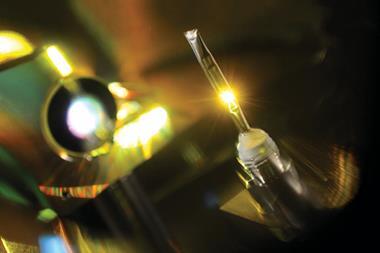‘Molecular movie’ provides new insight into classic ring-opening reaction
A team working at the Stanford Linear Collider (SLAC) in California claims to have made ‘the first molecular movie’ using ultra-fast x-ray scattering from molecules as they undergo a chemical reaction. They say that the experiment, aided by quantum-chemical simulations, enables them to figure out which reaction paths the process takes from the many available ones.
To watch the reaction unfold, Michael Minitti at SLAC, Peter Weber at Brown University in Rhode Island, and their colleagues have used the ultra-bright, pulsed x-rays produced by a free-electron laser at the Linac Coherent Light Source at SLAC. Such sources can now generate x-ray pulses intense enough to follow chemical reactions like this in real time by analysing the scattering from molecules in motion. Previously researchers at SLAC have snapped the formation of transition states using this technique.
Minitti and colleagues chose to study the ring-opening of 1,3-cyclohexadiene to form linear 1,3,5-hexatriene. This is the prototypical electrocyclic reaction, in which a rearrangement of conjugated bonding electrons makes or breaks a cyclic molecule. Such processes feature in a wide range of organic reactions useful to synthetic chemists. In this particular case the reaction is photochemical, triggered by ultraviolet light.
To watch it happen, the researchers used a classic ‘pump-probe’ approach. After initiating the ring-opening in a vapour of cyclohexadiene with a blast of UV laser light (the pump pulse), they fired a series of x-ray probe pulses into the reaction chamber, each lasting just 30 femtoseconds (10-15 s) and containing about a trillion x-ray photons. Changes in the shape of the molecule as the ring opens and unravels are reflected in the pattern of scattered x-rays.
Pathway predictions
A team of theorists led by Adam Kirrander at the University of Edinburgh, UK, who recently proposed using free-electron lasers to study the motion of electrons in real time, worked with the data produced. The team calculated 100 plausible trajectories of the cyclohexadiene molecules as they become hexatriene and compared the predicted scattering profiles with those measured experimentally over the 140 femtosecond duration of the reaction. Just four dominant trajectories were needed for a good match. These indicate that the carbon–carbon bonds of the ring first expand when photo-excited, and then the atoms at the break points move out of the molecular plane, with a stereochemistry that observes the famous Woodward–Hoffmann rules describing the electron orbital rearrangements in such a reaction.
While the reaction proceeds generally according to the picture already accepted, Kirrander says that the experiment reveals new subtleties. ‘We observe multiple reaction paths simultaneously, demonstrating that it’s an oversimplification to think of the reaction as proceeding along one single reaction path,’ he says.
‘This study can serve as a benchmark and springboard for larger molecules,’ Minitti says. And while gas phase reactions are simpler to understand and to model, making them ideal test cases, the researchers say that the approach should work for the condensed-phase and solution-based processes that are often of greatest interest to chemists. ‘Ultra-fast x-ray scattering could turn out to be one of the most powerful, if not the most powerful, technique for studying chemical reactions in the condensed phase,’ says Kirrander.
‘This work is a very significant advance for the use of x-rays in following chemical reaction dynamics,’ says R J Dwayne Miller of the Max Planck Institute for the Structure and Dynamics of Matter in Hamburg. ‘I never thought it would be possible to do gas phase reaction dynamics with x-rays as the scattering cross section is so small.’
Not the only game in town
But he cautions that this isn’t the only way to get at this kind of information: electron scattering has already been used for many years to do so. ‘Ultra-bright electron sources are very competitive with x-ray free-electron lasers for this class of experiment,’ Miller says. ‘Plenty of electron-scattering studies have achieved sub-picosecond time resolution of atomic motions.’
Kirrander argues that x-rays can give greater time resolution, because they don’t repel one another and so can be packed very densely into ultra-short pulses. On the other hand, electrons, which can have shorter quantum wavelengths, give better spatial resolution, says Miller: x-rays can’t reveal the atomic motions directly.
Jochen Küpper of the Centre for Free Electron Laser Science, also in Hamburg, agrees, questioning whether matching data with calculations can really be said to be equivalent to making a ‘molecular movie’. That, he says, should instead entail ‘the time-dependent experimental measurement of atom positions, or of bond length and angles’.












No comments yet